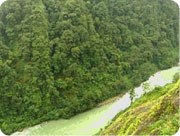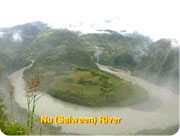Source: CCTV.com
08-02-2006 18:56

Welcome to travelogue! In this section, we will bring you to a place featuring such postcard-like scenery everywhere. It is probably the most remote area in China, the least traveled area, and the most challenging area for travelers. But consequently, you may get the best scenery and the most hospitable people here, welcome to Nujiang Valley!
Bordering Tibet on the north and Myanmar on the west, Nujiang lisu autonomous prefecture stretches from north to south for over 300 kilometers along the Nujiang valley in Yunnan Province.
Nujiang, also known as the Salween River in the west, originates from the Tangula Mountain on Qinghai-Tibet Plateau, cuts through the Hengduan Mountains on its way down south, and carves out one of the longest and deepest river valleys in the whole world.
In a distance of merely 700 kilometers, it descends 1578 meters, plunging through gorges like a roller coaster.
Almost half million people live inside this natural wonder; and over 90 percent of which is of ethnic groups, mainly, Lisu, Nu, Dulong, Pumi and Tibet.
Xiaolan: Today is the first day of my adventure into the Nujiang Gorge. And I'm taking off from the southern tip of Nujiang Valley which is Liuku. We are going to drive all the way up to the north for about 323 kilometers, that's a long haul today.
As a matter of fact, Xiaolan started to premeditate this Nujiang trip at the very moment when she was first introduced to the fascinating three Parallel River area during a previous trip to the neighboring Diqin Prefecture.

The three Parallel Rivers refer to Jinsha, Langcang, and Nujiang rivers. Recognized by the UNESCO as a world heritage Site, the area is the epicenter of Chinese biodiversity.
The area contains over 7000 different plant species and over 50 percent of China's animal species, some are extremely rare or endangered.
Situated west to Langcang and Jinsha Jiang, Nujiang is probably the most secluded and mysterious one out of the three.
Before the main road was built up, some local people never got an opportunity to get down from their villages high up on the mountain throughout their lifetimes. So you can imagine how overwhelmingly nice and friendly they would treat rare visitors.

The most famous road ferry crossing the Salween River is no doubt the Burma Road, a 1100-mile supply line that winds through three nation - India, Myammar, and China.
It was used by allied forces to transport war supplies from Myammar to Kunming during the World War II.
Other than the Burma Road, there is another vital transportation line connecting India, Myanmar and China during the Second World War; and it's known to the world as the Hump, getting its name from the shape of Nujiang valley. And it is probably the most dangerous flying route that's ever existed in the aviation history.
From the spring of 1942 until the war ended in August 1945, American pilots were tested as they crossed towering mountains in abysmal circumstances - violent turbulence, Japanese airfire, dreadful weather, malfunctioning airplanes.

